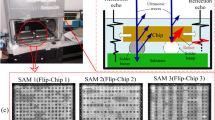Abstract
Solder bumps are widely used in surface mount components, which provide electrical and mechanical connection between the chip/package and the substrate. As the solder bump getting smaller in dimension and pitch, it becomes more difficult to inspect the solder defects hidden in the IC package. In this paper, an intelligent inspection method using the scanning acoustic microscopy (SAM) and the fuzzy C-means (FCM) algorithm was investigated. A flip chip package of FA10 was chosen as the test sample. The SAM tests of FA10 were carried out in C-scan mode. The sub-image of every solder bump was segmented from the SAM image. The statistical features were then calculated and adopted for clustering of solder bumps using the FCM algorithm. The recognition results of FCM reached a high accuracy of 94.3%. The intelligent system is effective for defect inspection in high density packages.
Similar content being viewed by others
References
Chen J K, Xu Z L, Huang Y A, et al. Analytical investigation on thermal-induced warpage behavior of ultrathin chip-on-flex (UTCOF) assembly. Sci China Tech Sci, 2016, 59: 1646–1655
Lu X, Shi T, Xia Q, et al. Thermal conduction analysis and characterization of solder bumps in flip chip package. Appl Thermal Eng, 2012, 36: 181–187
Asgari R. Challenges in 3D inspection of micro bumps used in 3D packaging. In: Proceedings of 45th International Symposium on Microelectronics. San Diego, 2012. 542–547
Liao G, Chen P, Du L, et al. Using SOM neural network for X-ray inspection of missing-bump defects in three-dimensional integration. Microelectron Reliab, 2015, 55: 2826–2832
Shen J, Chen P, Su L, et al. X-ray inspection of TSV defects with selforganizing map network and Otsu algorithm. Microelectron Reliab, 2016, 67: 129–134
Ahi K, Asadizanjani N, Shahbazmohamadi S, et al. Terahertz characterization of electronic components and comparison of terahertz imaging with X-ray imaging techniques. In: Proceedings Volume 9483, Terahertz Physics, Devices, and Systems IX: Advanced Applications in Industry and Defense. Baltimore, 2015
He Z, Wei L, Shao M, et al. Detection of micro solder balls using active thermography and probabilistic neural network. Infrared Phys Tech, 2017, 81: 236–241
Wei W, Wei L, Nie L, et al. Using active thermography and modified SVM for intelligent diagnosis of solder bumps. Infrared Phys Tech, 2015, 72: 163–169
Lu X, Shi T, Han J, et al. Defects inspection of the solder bumps using self reference technology in active thermography. Infrared Phys Tech, 2014, 63: 97–102
Su L, Shi T, Liu Z, et al. Nondestructive diagnosis of flip chips based on vibration analysis using PCA-RBF. Mech Syst Signal Process, 2017, 85: 849–856
Liao G, Du L, Su L, et al. Using RBF networks for detection and prediction of flip chip with missing bumps. Microelectron Reliab, 2015, 55: 2817–2825
Su L, Shi T, Du L, et al. Genetic algorithms for defect detection of flip chips. Microelectron Reliab, 2015, 55: 213–220
Brand S, Czurratis P, Hoffrogge P, et al. Automated inspection and classification of flip-chip-contacts using scanning acoustic microscopy. Microelectron Reliab, 2010, 50: 1469–1473
Su L, Zha Z, Lu X, et al. Using BP network for ultrasonic inspection of flip chip solder joints. Mech Syst Signal Process, 2013, 34: 183–190
Yang R S H, Braden D R, Zhang G M, et al. An automated ultrasonic inspection approach for flip chip solder joint assessment. Microelectron Reliab, 2012, 52: 2995–3001
Fan M, Wei L, He Z, et al. Defect inspection of solder bumps using the scanning acoustic microscopy and fuzzy SVM algorithm. Microelectron Reliab, 2016, 65: 192–197
Liu F, Su L, Fan M, et al. Using scanning acoustic microscopy and LM-BP algorithm for defect inspection of micro solder bumps. Microelectron Reliab, 2017, 79: 166–174
Lu X N, Shi T L, Wang S Y, et al. Intelligent diagnosis of the solder bumps defects using fuzzy C-means algorithm with the weighted coefficients. Sci China Tech Sci, 2015, 58: 1689–1695
Izakian H, Abraham A. Fuzzy C-means and fuzzy swarm for fuzzy clustering problem. Expert Syst Appl, 2011, 38: 1835–1838
Gong M, Liang Y, Shi J, et al. Fuzzy C-means clustering with local information and kernel metric for image segmentation. IEEE Trans Image Process, 2013, 22: 573–584
Chuang K S, Tzeng H L, Chen S, et al. Fuzzy C-means clustering with spatial information for image segmentation. Compized Med Imag Graphics, 2006, 30: 9–15
Author information
Authors and Affiliations
Corresponding author
Rights and permissions
About this article
Cite this article
Lu, X., Liu, F., He, Z. et al. Defect inspection of flip chip package using SAM technology and fuzzy C-means algorithm. Sci. China Technol. Sci. 61, 1426–1430 (2018). https://doi.org/10.1007/s11431-017-9185-6
Received:
Accepted:
Published:
Issue Date:
DOI: https://doi.org/10.1007/s11431-017-9185-6



